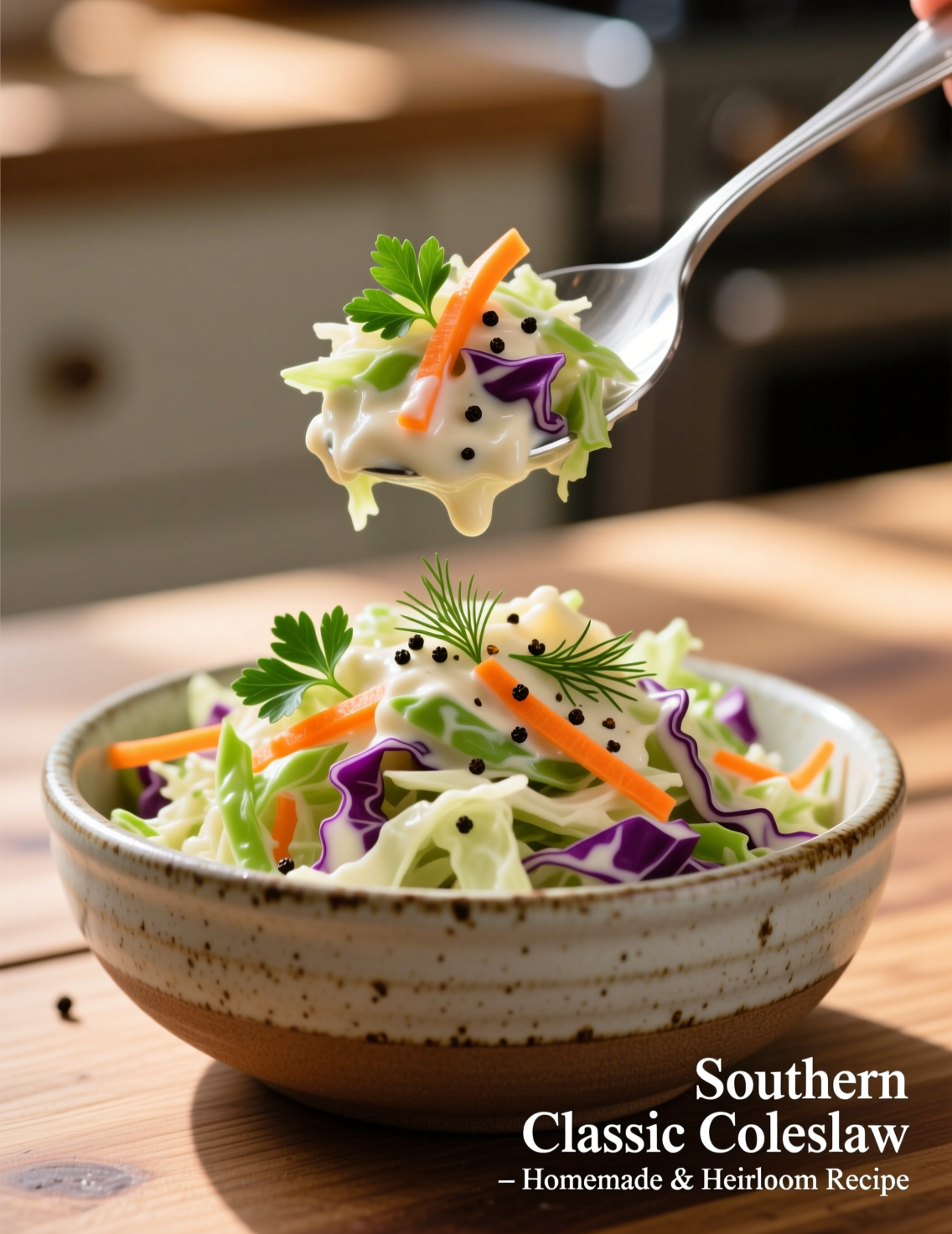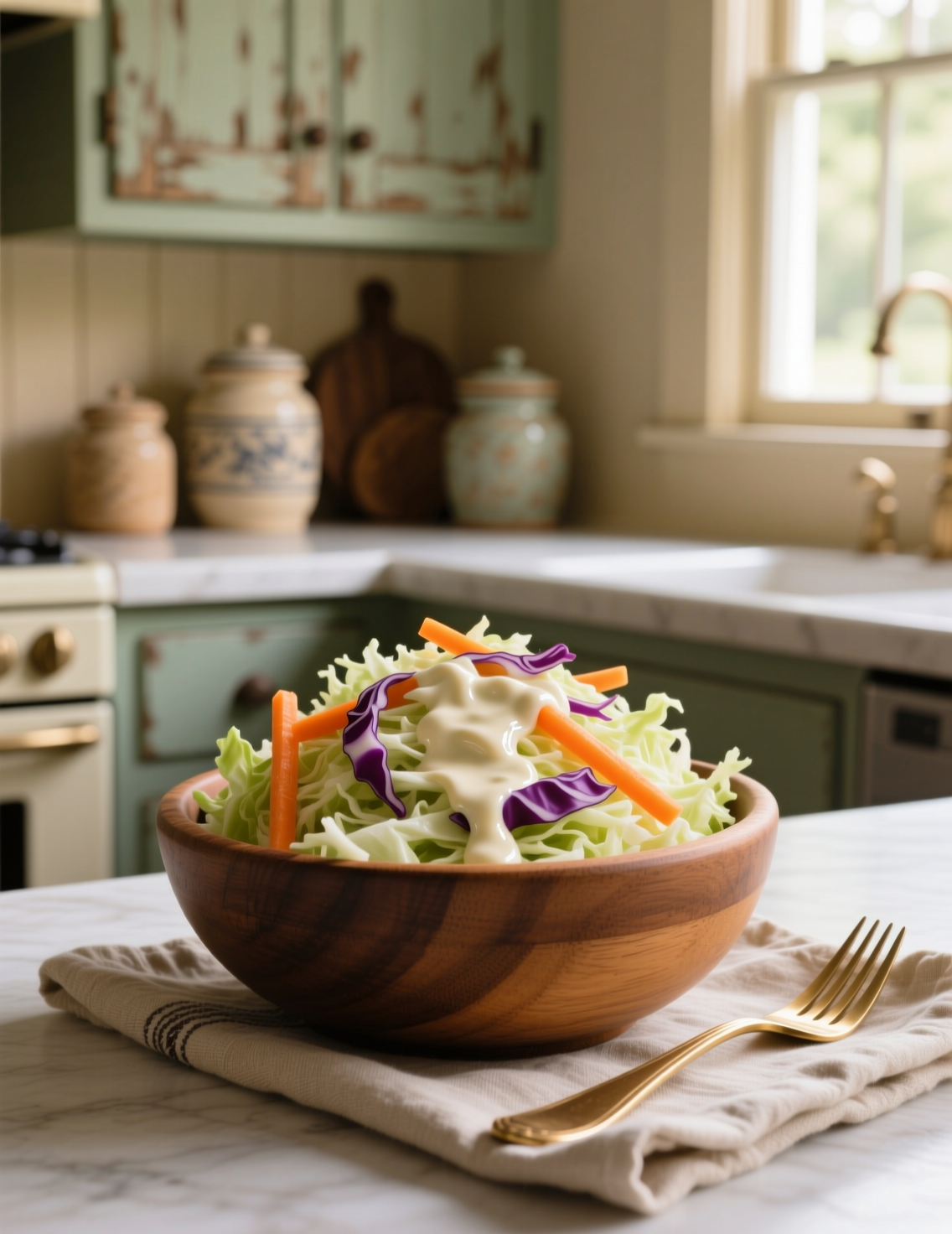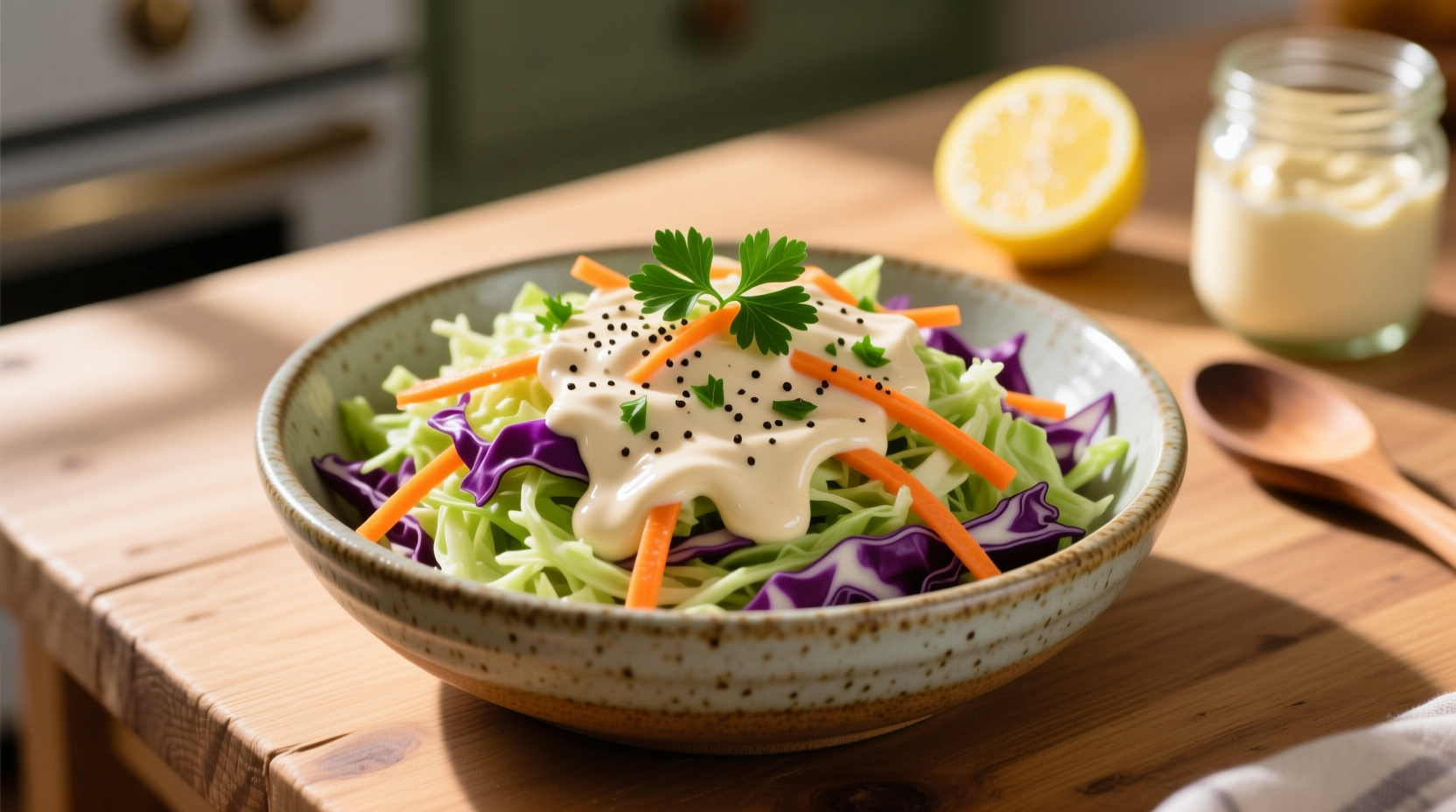Coleslaw might look simple. A bowl of shredded cabbage, some creamy dressing, maybe a sprinkle of carrot. But Southern coleslaw is more than that. It’s balance. It’s culture. It’s the kind of dish that sneaks its way onto the table and then holds its ground next to fried chicken, smoked ribs, or a pulled pork sandwich. Today we’ll break down the Southern coleslaw recipe for 6 servings in a way that cooks, chefs, and serious food professionals can appreciate.
Why Southern Coleslaw Matters
Coleslaw in the South isn’t just a side. It’s tradition. Across BBQ joints in Tennessee, Carolina seafood shacks, and Mississippi fish fries, you’ll find a bowl of slaw sitting in the center. Some places even put it directly on the sandwich, especially pulled pork. And for good reason. It cools the heat of spice rubs, it cuts through fat, and it adds crunch where otherwise everything’s soft.
Southern coleslaw is also one of those dishes that sparks debate. Mayo or vinegar? Sugar or no sugar? Coarse shred or thin slice? If you’re a chef, you know those arguments don’t stop in kitchens—they define them.
The Foundation: Cabbage and Carrots
The heart of coleslaw is cabbage. Southern recipes nearly always lean toward green cabbage, sometimes with a little red tossed in for color. Why green? It has the right balance of mild bitterness and water content. Napa or Savoy makes the texture too soft, while red alone can stain the whole dish.
Carrots play a supporting role. They bring color and a hint of sweetness that balances out cabbage’s earthiness. A good ratio for 6 servings is about one medium carrot to half a head of cabbage, though some cooks prefer heavier carrot for sweetness.
Shredding technique matters more than most people think. Thin, even cuts create better texture and absorb dressing more uniformly. In professional kitchens, a mandoline or food processor is the standard, but old-school chefs swear by a sharp knife and patience.

Dressing: The Soul of the Slaw
Southern coleslaw isn’t just chopped vegetables. It’s the dressing that sets it apart. And here’s where things get tricky.
The mayonnaise base dominates across most Southern kitchens. It gives creaminess and holds flavors together. But vinegar and sugar are the backbone. White vinegar or apple cider vinegar creates acidity, while sugar balances it. Together, they form the tang-sweet combo Southern slaw is famous for.
For 6 servings, a classic ratio looks like this:
- ½ cup mayonnaise
- 2 tablespoons apple cider vinegar
- 1 tablespoon sugar
- ½ teaspoon celery seed
- ½ teaspoon salt
- ¼ teaspoon black pepper
Celery seed is often overlooked, but in the South, it’s nearly sacred in coleslaw. It gives a sharp, slightly bitter herbal note that keeps the dish from leaning too sweet. Some chefs also add a pinch of mustard powder for warmth.
Balancing Sweetness and Acidity
Professional cooks know balance is everything. Too much vinegar and the slaw becomes sour. Too much sugar and it starts tasting like dessert.
The balance depends not just on taste, but also on what the slaw will be paired with. If it’s meant for fried chicken, lean heavier on vinegar to cut grease. If it’s going onto pulled pork, add more sugar to balance the smoky-savory profile. Chefs in Memphis will often tweak sweetness higher, while in North Carolina the vinegar hits sharper.
An interesting data point: A 2019 survey of Southern BBQ restaurants in Southern Living found that 61% of places leaned toward sweet-style slaw, while only 39% kept it vinegar-dominant. That tells us the sweet-to-tang ratio isn’t just personal—it’s regional.
The Resting Period
Here’s where most home cooks mess up. Coleslaw isn’t made and eaten straight away, at least not in the South. It needs to rest.
Once dressed, cabbage starts releasing water. The salt and sugar draw it out, which then blends back into the dressing, creating that slightly thinner but well-soaked texture. An hour minimum in the fridge is necessary, though professionals often let it sit overnight.
There’s also science behind it. Cabbage contains glucosinolates, sulfur compounds that mellow over time. Letting coleslaw rest means those sharp raw flavors soften, giving a smoother taste.
Step-by-Step Recipe for 6 Servings
Here’s a professional-level recipe you can scale up or down.
Ingredients:
- ½ head green cabbage (about 1 ½ pounds), finely shredded
- 1 medium carrot, grated
- ½ cup mayonnaise
- 2 tablespoons apple cider vinegar
- 1 tablespoon sugar (adjust as needed)
- ½ teaspoon celery seed
- ½ teaspoon kosher salt
- ¼ teaspoon freshly ground black pepper
Instructions:
- Shred the cabbage finely, either by mandoline or knife. Place in a large mixing bowl.
- Add grated carrot. Toss lightly to mix.
- In a separate bowl, whisk together mayonnaise, vinegar, sugar, celery seed, salt, and pepper.
- Pour dressing over cabbage mixture. Mix gently but thoroughly until evenly coated.
- Cover and refrigerate for at least 1 hour before serving.
This yields 6 servings, though portion sizes in the South are generous—expect it to disappear fast.

Common Mistakes Chefs Notice
- Overdressing – Too much mayo turns slaw heavy and masks the freshness. Professionals start light, then add more only if the cabbage needs it.
- Skipping the rest – Serving right away leaves it harsh and watery later. Always allow it to chill.
- Shredding too thick – Thick chunks don’t absorb flavor and ruin mouthfeel. Aim for strands no thicker than a matchstick.
- Wrong vinegar – Balsamic or red wine vinegars overpower the dish. Stick to white or apple cider.
- Ignoring salt balance – Salt isn’t just for taste—it controls water release from cabbage. Under-salting means a dry slaw, over-salting means a puddle at the bottom of the bowl.
Variations That Still Count as Southern
Not all Southern slaws are identical. A few respected twists exist:
- Duke’s Mayonnaise Base – In the Carolinas, using Duke’s is almost non-negotiable. It’s tangier than Hellmann’s and gives authentic flavor.
- Sweet Pickle Juice – Some Mississippi recipes add a spoonful of pickle brine for an extra layer of sweetness.
- Hot Pepper Kick – Louisiana versions may include a dash of hot sauce or cayenne.
- Mustard Slaw – In certain Alabama BBQ joints, you’ll find yellow mustard whisked into the dressing for a bold, tangy finish.
These variations keep the spirit of the dish but adapt it to local flavor profiles.
Coleslaw in Modern Kitchens
Professional chefs today are rethinking coleslaw. Some lighten it with Greek yogurt to cut calories. Others use honey instead of sugar. A few even swap cabbage for kale or Brussels sprouts. But here’s the truth: in the South, none of those would fly in a BBQ joint.
Still, modern diet trends push restaurants to adapt. A 2021 NRA (National Restaurant Association) report noted that 43% of chefs had adjusted classic sides like coleslaw to meet “healthier” demands. So you’ll find lighter mayo, reduced sugar, or even oil-based slaws showing up in urban kitchens.
But authenticity still matters. If you’re running a Southern-inspired menu, stray too far and customers notice.
Pairings That Elevate
Coleslaw isn’t meant to stand alone. Its purpose is harmony. Professionals know you never serve slaw just to fill space—it’s strategic.
- With BBQ Pork – Sweet slaw balances smoky pulled pork. Pile it right on the sandwich.
- With Fried Catfish – Tangy slaw cuts through fried batter and brings freshness.
- With Ribs – Creamy slaw cools down spice rubs and keeps the plate from feeling heavy.
- With Fried Chicken – Vinegar-forward slaw sharpens the edges and makes the meal cleaner.
The best pairing is about adjusting the slaw itself. That’s the chef’s role—slaw isn’t static, it’s adaptive.
Emerging Trends: Fermented Cabbage and Probiotic Slaws
One interesting modern twist is the rise of fermentation. Instead of quick-pickled or fresh slaw, some chefs are experimenting with lightly fermented cabbage, similar to sauerkraut but milder. This adds probiotics and deeper tang, appealing to health-conscious diners.
However, fermentation changes the dish’s texture. A true Southern coleslaw is crisp, creamy, and fresh, so fermented versions walk a fine line. Some BBQ spots in Atlanta have introduced hybrid versions: part fresh, part fermented. Early reviews suggest diners enjoy the complexity.
Final Expert Notes
Southern coleslaw for 6 servings may seem basic, but professionals know—it’s a dish of precision. The shred size, the mayo-to-vinegar ratio, the resting period. Every detail counts. Too loose and it drowns, too stiff and it tastes flat.
As a chef, think about purpose. Is this slaw cooling the heat of cayenne fried chicken? Or is it mellowing the smoke of a hickory pit? Your ratio changes with the plate. That’s what makes it art, not just salad.
The takeaway: don’t treat Southern coleslaw as filler. Treat it as a strategic side that enhances every bite of the main dish. Perfect it, and you’ll see guests notice—even if they can’t tell you why.
FAQs
What type of cabbage is best for Southern coleslaw?
Green cabbage is preferred for its mild flavor and crisp texture.
Can I use red cabbage in this recipe?
Yes, but use it sparingly to avoid staining and overpowering the flavor.
How long should Southern coleslaw rest before serving?
At least 1 hour in the fridge for best flavor and texture.
Is mayonnaise necessary for authentic Southern coleslaw?
Yes, it provides the creamy base essential to the classic taste.
Can I substitute apple cider vinegar with white vinegar?
Yes, both work, though apple cider gives a slightly sweeter tang.
Should I add sugar to the dressing?
Yes, a little sugar balances the vinegar and enhances flavor.
What’s the ideal shred size for cabbage and carrots?
Thin, matchstick-sized shreds ensure even texture and flavor absorption.
Can Southern coleslaw be made ahead?
Absolutely, it can be made a day ahead and refrigerated.
Are there regional variations of Southern coleslaw?
Yes, some areas use sweeter, tangier, or mustard-based dressings.
Can I make a lighter version of this slaw?
Yes, you can use Greek yogurt or reduced mayo for a lighter option.
Does celery seed really matter?
Yes, it adds a signature herbal note essential for authentic flavor.
Can I add hot sauce to the slaw?
Yes, a small dash works for a subtle Southern-style kick.
How many servings does this recipe make?
It makes 6 generous servings.
Can I ferment the cabbage for a probiotic version?
Yes, but it changes texture; classic slaw remains crisp and fresh.
What dishes pair best with Southern coleslaw?
Pulled pork, fried chicken, ribs, and fried catfish are perfect matches.

Mariana is a passionate home cook who creates delicious, easy-to-follow recipes for busy people. From energizing breakfasts to satisfying dinners and indulgent desserts, her dishes are designed to fuel both your body and hustle.
When she’s not in the kitchen, she’s exploring new flavors and dreaming up her next recipe to share with the Foodie Hustle community.

